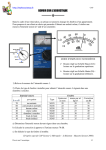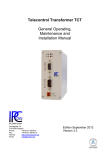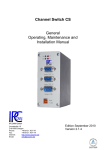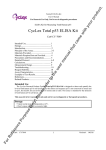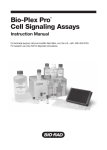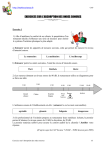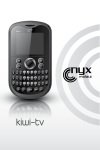Download IPC191 Manual
Transcript
Industrial PC IPC191V2 General Operating, Maintenance and Installation Manual Hardware Platform Protocol Converter Gundstraße 15 D-91056 Erlangen Phone: +49 9131 7677 47 Fax: +49 9131 7677 78 Internet: http://www.ipcomm.de Email: [email protected] Edition November 2007 Version 1.0.2 Index 1 INTRODUCTION .............................................................................................................................. 1 2 HARDWARE DESCRIPTION .......................................................................................................... 2 2.1 GENERAL .................................................................................................................................... 2 2.2 HARDWARE COMPONENTS ........................................................................................................... 3 2.2.1 Mainboard .......................................................................................................................... 3 2.2.2 CPU-Module RS232 Interfaces ......................................................................................... 4 2.2.3 Hardlock Dongle ................................................................................................................ 5 2.2.4 8-Port RS232 Communication Board (RS232 Interfaces for remote communication) ...... 5 2.2.5 Ethernet Interfaces ............................................................................................................ 5 2.2.6 CompactFlash .................................................................................................................... 6 2.2.7 CMOS Lithium Battery ....................................................................................................... 6 2.2.8 CPU LED ........................................................................................................................... 7 2.2.9 Power Supply ..................................................................................................................... 8 3 INTERFACE CONFIGURATION ..................................................................................................... 9 3.1.1 3.1.2 3.1.3 3.1.4 3.1.5 Model A .............................................................................................................................. 9 Model C.............................................................................................................................. 9 Model B ............................................................................................................................ 10 Modell L ........................................................................................................................... 10 Modell D ........................................................................................................................... 10 4 TECHNICAL DATA........................................................................................................................ 11 5 APPENDIX ..................................................................................................................................... 12 5.1 IPC191 CAD DRAWING ............................................................................................................ 13 1 Introduction All technical information, descriptions and illustrations contained in this Operating, Maintenance and Installation Manual remain our property and shall not be used otherwise than for operating this System, nor shall they be copied, reproduced or passed on to third parties or brought to their notice without our prior written consent. The information represented in this manual is in keeping with current standards and is subject to later alterations. This manual contains important instructions referring to safe installation, commissioning, operation and maintenance. Read this manual carefully before starting up the protocol converter and observe the instructions. In order to comply with the guidelines for electro-magnetic compatibility in industrial PCs (or other variants) only CE-certified components are used in compliance with project-specific requirements. It is to be noted that the Protocol Converter (IPC191) has not been protected against lightning and the operator should, if desired, take appropriate protective precautions. All trademarks and brand names contained in this user manual are for identification purposes only and can be owned by their respective holders. Finally we want to draw your attention to the fact that any warranties with respect to delivered goods will be invalid in the event that: • Operation, servicing and maintenance are not carried out accurately according to the instructions, repairs are not carried out by our personnel or without our prior written consent. • Commissioning is not carried out by our personnel or we have not given our approval for the commissioning or the commissioning is carried out by untrained personnel. • The unit is used inadequately, incorrectly, negligently or inappropriately or for a purpose other than that originally intended. • The serial number is removed from the product. For your protection, observe the following safety precautions when setting up your equipment: • Follow all cautions and instructions marked on the equipment. • Ensure that the voltage and frequency of your power source match the voltage and frequency inscribed on the equipment's electrical rating label. • Never push objects of any kind through openings in the equipment. Dangerous voltages may be present. Conductive foreign objects could produce a short circuit that could cause fire, electric shock, or damage to your equipment. Subject to alterations IPCOMM GmbH Gundstraße 15 D-91056 Erlangen Version 1.0.2 -1- IPC191 V2 Manual Copyright © 2007 IPCOMM GmbH All rights reserved 2 2.1 Hardware Description General As hardware platform for the protocol converter a 19” industrial PC is used. This solution offers a high degree on flexibility, performance and reliability. Mounting and intensive tests of the industrial PC are done in our company. Before and after a 48 hour Burn-in Test each device must run through a complete function test All components are cooled passively. Only if critical system temperatures have been reached two independent housing fans are switched on automatically. Important for the selection of our components are particularly items like quality, availability and a high durability. The industrial PC consists of a 19“ chassis (1U) with an integrated Dual PCI riser card for inserting the appropriate cards. The mains power supply is 90 – 264 V AC, 127 – 373 V DC autorange, optional 10 – 30 V DC power supply (other on request). S/N, Model, Voltage CompactFlash Card Power LED DVD-RW Drive Power Button CPU LED Figure 1. Subject to alterations IPCOMM GmbH Gundstraße 15 D-91056 Erlangen COM 2 Port Front view Industrial PC Version 1.0.2 -2- IPC191 V2 Manual Copyright © 2007 IPCOMM GmbH All rights reserved On the figure 2 you can see the reverse side of our Industrial PC. The pin assignments vary according to execution. Overview of the different models is to be found under 3. Interface Configuration. Main Power Supply input Monitor LAN LAN PCI 2 Keyboard PCI 1 e.g.: COM 4 – COM 11 COM 1 8 Port DB 9 Male connector cable (Optional: DB25 (Male, Female) ) Figure 2. 2.2 2.2.1 Overview Interfaces Hardware Components Mainboard The Mini-ITX Mainboard is an ultra compact x86 dual LAN platform with all the necessary interfaces. Its heart consists of a fanless highly efficient embedded VIA Eden processor. The mainboard provides one DIMM slot for DDR memory modules and supports up to 1GB system memory. The following interfaces are provided by the CPU module: • • • • • • 2 x RS232 Interface (model-specific) 2 x RJ45 LAN Interface Bi-directional Parallel Port EIDE Interface VGA Interface Keyboard- / Mouse Port Subject to alterations IPCOMM GmbH Gundstraße 15 D-91056 Erlangen Version 1.0.2 -3- IPC191 V2 Manual Copyright © 2007 IPCOMM GmbH All rights reserved 2.2.2 CPU-Module RS232 Interfaces The installed mainboard provides 3 serial interfaces. However, depending on the model these interfaces are completely or only partly available at the chassis. COM 2 – COM 3 do not possess an RI signal. The signal level of the serial interfaces can be changed between 5 and 12 V by means of a jumper. COM3 interface is reserved for internal purpose and can not be used. This interface type is used for COM 1 SERIAL PORT RS232 DTE DB9 male connector Pin Direction Description 1 INPUT DCD Data Carrier Detect 2 INPUT RXD Receive Data 3 OUTPUT TXD Transmit Data 4 OUTPUT DTR Data Terminal Ready 5 Figure 3. GND Ground 6 INPUT DSR Data Set Ready 7 OUTPUT RTS Request To Send 8 INPUT CTS Clear To Send 9 INPUT RI Ring Indicator Pin Assignment of DB9 Interface (Computer) COM1 This interface type is used for COM 2 – COM 4 SERIAL PORT RS232 DTE DB9 male connector Pin Direction Description 1 INPUT DCD Data Carrier Detect 2 INPUT RXD Receive Data 3 OUTPUT TXD Transmit Data 4 OUTPUT DTR Data Terminal Ready 5 GND Ground 6 INPUT DSR Data Set Ready 7 OUTPUT RTS Request To Send 8 INPUT CTS Clear To Send 9 Figure 4. Pin Assignment of DB9 Interface (Computer) COM2 – COM4 Subject to alterations IPCOMM GmbH Gundstraße 15 D-91056 Erlangen Version 1.0.2 -4- IPC191 V2 Manual Copyright © 2007 IPCOMM GmbH All rights reserved 2.2.3 Hardlock Dongle The hardlock dongle is a hardware protection for the software. It must be attached onto the parallel interface. Without hardlock dongle the software does not boot! Figure 5. 2.2.4 Hardlock Dongle 8-Port RS232 Communication Board (RS232 Interfaces for remote communication) Each IPC191 can be equipped with up to two serial interface cards. SERIAL PORT RS232 DTE DB9 male connector Pin Direction Description 1 INPUT DCD Data Carrier Detect 2 INPUT RXD Receive Data 3 OUTPUT TXD Transmit Data 4 OUTPUT DTR Data Terminal Ready 5 GND Ground 6 INPUT DSR Data Set Ready 7 OUTPUT RTS Request To Send 8 INPUT CTS Clear To Send 9 Figure 6. 2.2.5 Pin Assignment of DB9 interface (Communication Board) Ethernet Interfaces The industrial PC features up to two Ethernet Interfaces generally. The connection is set up via a 10/100 Mbps BaseT (RJ45) interface. Further Interfaces with 10/100 Mbps or 10/100/1000 Mbps BaseT are possible on request. Subject to alterations IPCOMM GmbH Gundstraße 15 D-91056 Erlangen Version 1.0.2 -5- IPC191 V2 Manual Copyright © 2007 IPCOMM GmbH All rights reserved 2.2.6 CompactFlash The CompactFlash card serves as a mass storage device, i.e. for storing the operating system, the applications and configuration data. As a result the disadvantages involved with the use of a rotating harddisk are avoided, thus improving the reliability of the system substantially since a CompactFlash has an MTBF of at least 4,000,000 hours. The CompactFlash adapter is simply connected to the IDE bus of the CPU module and treated just like a hard disk. Push to take CompactFlash out Figure 7. CompactFlash Adapter With the power supply switched off the CompactFlash card can simply be taken out or inserted enabling a quick change to different hardware. 2.2.7 CMOS Lithium Battery The onboard CMOS RAM stores system configuration data and has an onboard battery power supply. The long-life Lithium battery has normally a lifetime of at least 5 years. If the CMOS battery is empty and the CMOS information has been deleted, the CMOS-RAM is programmed by the BIOS with default settings. The converter can be operated faultlessly even if the CMOS RAM is not provided by the battery. After the battery has been changed only time and date must be input. For opening the case 3 screws on the top must be removed. The battery holder is soldered in the Mainboard and well visible. Attention: Open-frame power supplies are used. Because of this, the process should be carried out only by experienced electronic engineers. The device must be completely disconnected from any power supply. Before opening please push the power button (without electricity supply) several times to eliminate residual voltages of the power supply. Battery replacement must be carried out by qualified specialists. CAUTION! Incorrect replacement might cause the danger of explosion. Replace the battery exclusively by the same type (3 V DC, CR2032). Used batteries are to be disposed absolutely in accordance with the manufacturer's instructions. Please pay attention to the correct polarity! Subject to alterations IPCOMM GmbH Gundstraße 15 D-91056 Erlangen Version 1.0.2 -6- IPC191 V2 Manual Copyright © 2007 IPCOMM GmbH All rights reserved 2.2.8 CPU LED The CPU LED shows the states of conversion software and operating system. Following figure shows all possible indications: Passive Mode (Standby) 0,5 ON OFF Active Mode 0,5 5s ON OFF Software has stopped ON OFF Figure 8. CPU-LED indications Subject to alterations IPCOMM GmbH Gundstraße 15 D-91056 Erlangen Version 1.0.2 -7- IPC191 V2 Manual Copyright © 2007 IPCOMM GmbH All rights reserved 2.2.9 Power Supply Power supplies with different input voltages can be used in the IPC191. Please pay attention to the correct polarity and input voltage. 2.2.9.1 AC Power Supply By using AC voltages a specific power supply cable (Fig. 8) is supplied. Please use this cable exclusively. Figure 9. Power Cable 2.2.9.2 DC Power Supply By using DC voltages only a male connector is supplied. This connector has to be used. By connecting the cable with the male connector the correct polarity must be kept. The wire cross-section must be at least 1,5 mm². Connection for Earth Potential Power Supply Input Power Supply Input - + DC Power Cable (Example, not included in delivery) Label for correct Power Voltage (e. g. 24 V) Figure 10. DC Power Connection socket Subject to alterations IPCOMM GmbH Gundstraße 15 D-91056 Erlangen Version 1.0.2 -8- IPC191 V2 Manual Copyright © 2007 IPCOMM GmbH All rights reserved 3 Interface Configuration The following tables represent the configuration of the individual interfaces of miscellaneous models. The setting is carried out either in the BIOS or via jumpers on the appropriate card depending on the unit. The allocation diagram of the link can be found in the documentation of the component. 3.1.1 Model A Assembly Device I/O port IRQ Mainboard ser1 3F8 4 ser2 ser3 en1 en2 2F8 3E8 PCI PCI 3 5 PCI PCI Label IOIOI (Chassis rear) IOIOI (Chassis front) CPU (Diagnose) LAN1 LAN2 ser4 ser5 ser6 ser7 ser8 ser9 ser10 ser11 PCI PCI PCI PCI PCI PCI PCI PCI PCI PCI PCI PCI PCI PCI PCI PCI COM4 COM5 COM6 COM7 COM8 COM9 COM10 COM11 DB9ST DB9ST DB9ST DB9ST DB9ST DB9ST DB9ST DB9ST Assembly Device I/O port IRQ Connector Mainboard ser1 3F8 4 ser2 ser3 en1 en2 2F8 3E8 PCI PCI 3 5 PCI PCI Label IOIOI (Chassis rear) IOIOI (Chassis front) CPU (Diagnose) LAN1 LAN2 DB9ST NOT Connected RJ45 RJ45 en3 PCI PCI LAN3 RJ45 ser4 ser5 ser6 ser7 ser8 ser9 ser10 ser11 PCI PCI PCI PCI PCI PCI PCI PCI PCI PCI PCI PCI PCI PCI PCI PCI COM4 COM5 COM6 COM7 COM8 COM9 COM10 COM11 DB9ST DB9ST DB9ST DB9ST DB9ST DB9ST DB9ST DB9ST UART 1 3.1.2 DB9ST DB9ST NOT Connected RJ45 RJ45 Model C Ethernet 10/100 BaseT UART 1 Subject to alterations IPCOMM GmbH Gundstraße 15 D-91056 Erlangen Connector DB9ST Version 1.0.2 -9- IPC191 V2 Manual Copyright © 2007 IPCOMM GmbH All rights reserved 3.1.3 3.1.4 3.1.5 Model B Assembly Device I/O port IRQ Mainboard ser1 3F8 4 ser2 ser3 en1 en2 2F8 3E8 PCI PCI 3 5 PCI PCI Label IOIOI (Chassis rear) IOIOI (Chassis front) CPU (Diagnose) LAN1 LAN2 UART 1 ser4 ser5 ser6 ser7 ser8 ser9 ser10 ser11 PCI PCI PCI PCI PCI PCI PCI PCI PCI PCI PCI PCI PCI PCI PCI PCI COM4 COM5 COM6 COM7 COM8 COM9 COM10 COM11 DB9ST DB9ST DB9ST DB9ST DB9ST DB9ST DB9ST DB9ST UART 2 ser12 ser13 ser14 ser15 ser16 ser17 ser18 ser19 PCI PCI PCI PCI PCI PCI PCI PCI PCI PCI PCI PCI PCI PCI PCI PCI COM4 COM5 COM6 COM7 COM8 COM9 COM10 COM11 DB9ST DB9ST DB9ST DB9ST DB9ST DB9ST DB9ST DB9ST Assembly Device I/O port IRQ Connector Mainboard ser1 3F8 4 ser2 ser3 en1 en2 2F8 3E8 PCI PCI 3 5 PCI PCI Label IOIOI (Chassis rear) IOIOI (Chassis front) CPU (Diagnose) LAN1 LAN2 Assembly Device I/O port IRQ Mainboard ser1 3F8 4 ser2 ser3 en1 en2 2F8 3E8 PCI PCI 3 5 PCI PCI Label IOIOI (Chassis rear) IOIOI (Chassis front) CPU (Diagnose) LAN1 LAN2 ser4 PCI PCI COM4 DB9ST DB9ST NOT Connected RJ45 RJ45 Model L DB9ST DB9ST NOT Connected RJ45 RJ45 Model D USART 1 Subject to alterations IPCOMM GmbH Gundstraße 15 D-91056 Erlangen Connector Connector DB9ST DB9ST NOT Connected RJ45 RJ45 DB25ST Version 1.0.2 - 10 - IPC191 V2 Manual Copyright © 2007 IPCOMM GmbH All rights reserved 4 Chassis Power Supply Mainboard Serial Cards Mass Storage Video General Operating Environment Technical Data • • • 19“ rack mount chassis (1U) Dual PCI riser card Excellent air flow for maximum heat dissipation • • • • Fanless 90 – 264 V AC, 127 – 373 V DC autorange, optional 24 V DC, further voltages on request Power consumption: max. 50 W (depending on the used type) CE/TÜV certified • • • • • • • • VIA Eden processor 600 MHz CPU Max 1 GB DDR RAM EIDE hard disk and flash disk drive interface Digital I/O Interface 2 x high speed serial ports Bi-directional parallel port Real-time clock/calendar 2 x RJ45 10/100BaseT LAN interface onboard • • • • Up to sixteen serial RS232 ports DB9 male connectors, optional DB25 (Male, Female) 50 bps to 921.6Kbps transmission speed 16KV ESD Protection • • • • • • • Rugged CompactFlash, Industrial – Grade Removable flash card No Moving Parts 64 MB, max. 4 GB supported Vibration: 15 G peak to peak max. Shock: 1000 G max. MTBF ≥ 4.000.000 hours • Standard VGA graphic adapter • • • • All components are CE certified Height: 1 U Dimension (W x H x D): 19" x 1.75" x 15" (482.6 mm x 44.45 mm x 381 mm) Weight: 5,80 kg • • • Operating Temperature: 0° C to 45° C Storage Temperature: 0° C to 60° C Relative Humidity (non condensing): 5 % to 90 % Assembled by IPCOMM GmbH/Germany Subject to alterations IPCOMM GmbH Gundstraße 15 D-91056 Erlangen Version 1.0.2 - 11 - IPC191 V2 Manual Copyright © 2007 IPCOMM GmbH All rights reserved 5 Appendix Subject to alterations IPCOMM GmbH Gundstraße 15 D-91056 Erlangen Version 1.0.2 - 12 - IPC191 V2 Manual Copyright © 2007 IPCOMM GmbH All rights reserved
















